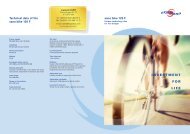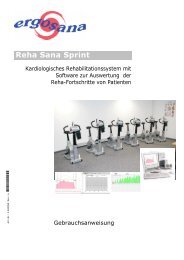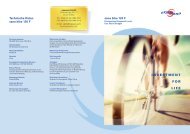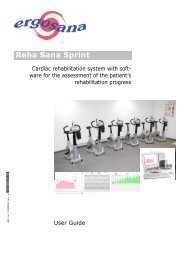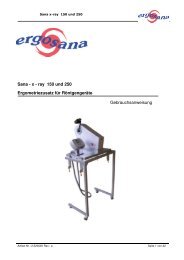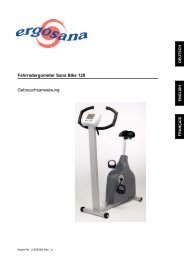Sicherheitsliege–Halbliegeergometer Sana ... - ergosana GmbH
Sicherheitsliege–Halbliegeergometer Sana ... - ergosana GmbH
Sicherheitsliege–Halbliegeergometer Sana ... - ergosana GmbH
You also want an ePaper? Increase the reach of your titles
YUMPU automatically turns print PDFs into web optimized ePapers that Google loves.
7.4 Training Program (Option)<br />
<strong>Sana</strong> couch 250 L and <strong>Sana</strong> cardio 250 SE<br />
The use of the training program requires a pulse signal receiver (Polar system), which is<br />
integrated in the control panel. The receiver can be ordered together with the device or added<br />
later on.<br />
The patient wears a transmitter belt, which is positioned on the skin below the chest. The<br />
effective radius of the signals transmitted by the belt and received in the control panel is<br />
approx. 70 cm. Please note that if the skin is dry, contact problems may occur between the belt<br />
and the skin at the beginning of the training. Therefore, if the pulse transmission is unsteady or<br />
disturbed, moisten the contact surfaces of the transmitter belt with contact spray or water.<br />
7.4.1 Training with Constant Heart Rate (Pulse-Steady-State)<br />
A bicycle ergometer training with constant heart rate (pulse-steady-state method) in the<br />
individual training range is a highly efficient and risk-free training method for the<br />
cardiopulmonary system. Ask your physician which is the suitable training heart rate for you. He<br />
or she will determine it for you using an exercise test.<br />
7.4.2 Configuring a Training Program on the Ergometer<br />
To define a training program, select the menu option<br />
Define program. Then select the menu option Training using the arrow keys.<br />
The below settings panel is displayed.<br />
To set or change the parameters in order, press modify.<br />
The first setting defines the<br />
Initial load, e.g. 50 watts.<br />
The setting Duration A1 controls the duration of warming-up phase 1, e.g. 1min.<br />
The setting Increase in load controls by how many watts per minute the load is increased.<br />
This is warming-up phase 2.<br />
In special cases, this phase can be<br />
limited in time using the next setting<br />
Duration A2. By default, the warming-up<br />
phase 2 is finished when the target HR is<br />
reached.<br />
When the target HR is reached, the load<br />
applied is automatically reduced by 10%.<br />
This measure is to prevent a too great<br />
heart rate increase during the training<br />
phase (TP), which now begins.<br />
The Target HR is set by the next<br />
parameter. The setting Duration of<br />
training controls the duration of the<br />
training phase (TP). The setting Cool<br />
down controls the period of time in which<br />
the load is reduced to 0 watts after<br />
termination of the training phase. The<br />
following settings Ask for Po – no/yes, Ask for HR – no/yes and Ask for weight – no/yes can<br />
be viewed when a new training is started and edited. Editing these parameters can be<br />
required when different persons want to use the training program.<br />
Article no.: 2.520027 Rev.:d Page 20 of 26




